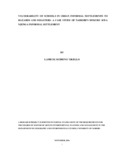| dc.description.abstract | Informal settlements in urban areas around the world are usually faced with a number of environmental hazards largely due to the very high population densities characterising these areas. Some of the environmental hazards in the urban informal settlements include pollution, fire, demolitions, sanitation challenges, and electric faults among others. Among the informal settlements are to be found education institutions and learners usually exposed to the hazards and this is largely attributed to lack of social infrastructures as informal settlements tend to exist outside the formal provisions budgets of many urban authorities. The lack of essential services results in learners in informal settlement schools being highly exposed to many hazards. This study addressed the problem of vulnerability of education institutions and learners to the environmental hazards and disasters in terms of types of risks, factors influencing vulnerability to hazards and mitigations measures. Solutions to the problems were aimed at determining the types of hazards and disasters, factors affecting vulnerability to hazards and disasters and, appropriate mitigation measures in Mukuru Kwa Njenga schools’ environment. The study used the hypotheses that there were no hazards and potential disasters facing students in the schools in Mukuru Kwa Njenga; schools in Mukuru Kwa Njenga were not located in hazardous environments making them vulnerable and lastly; there were no satisfactory mitigation measures put in place to reduce the vulnerability of Mukuru Kwa Njenga schools to hazards.
The study was carried out in Mukuru kwa Njenga informal settlements in Nairobi, Kenya where 12 primary schools and 2 secondary schools, respectively were included in the sample data. The schools included in the sample survey were purposely selected based on the fact that they were the only schools within the Mukuru kwa Njenga amongst the many schools in Mukuru informal settlement area. From the 12 primary schools and 2 secondary schools, 336 students, 64 teachers and 14 head teachers were included in the sample data. The resulting data file was used in the data analysis procedures including descriptive statistical techniques for distribution tendencies measures (central tendency and dispersion tendency) and inferential statistical techniques mainly dealing with measures of difference. The descriptive statistical tools used included frequency tabulation and graphical representation. From the results of descriptive analysis, appropriate inferential statistical tools were identified for measuring differences in types of hazards and disasters, factors of vulnerability and mitigation measures. The inferential techniques used were chi-squares test, ANOVA and z-test (significance in all cases tested at α0.05).
The types of hazards and disasters facing schools in Mukuru Kwa Njenga were determined to be flooding, sewage leaks, demolitions, robbery with violence, fire and election related violence. Factors that made schools and learners to be vulnerable to the identified hazards and disasters were inadequacy of learning facilities and resources including furniture, clean food and water, inadequate disaster prevention tools like firefighting equipment, insecure environment and location in relation to proximity to some of the hazards. The mitigation measures were found to include improvement of security measures around the schools by erecting perimeter walls, gates and employing and training already employed security guards, conducting security drills, improving drainage within and around the schools, and employing guidance and counselling professionals to handle the aftermath of hazards and disasters.
This study made the following recommendations to minimize vulnerability of schools in urban marginalized areas. The schools within urban informal settlements should be helped to cope with the high population of students that they are faced with. Relevant authorities should ensure training on hazards and disaster response is given to all those who want to run private schools. The government should take necessary steps to inspect and document the school’s status and the hazards they face. Further, there is need for licensed water supplying institutions to make schools a priority target for their supply. Finally, a similar research as this should be undertaken using a larger sample. This will show if the findings of this study are area specific or that the conclusions can be replicated elsewhere thus necessitating similar mitigation measures. | en_US |



